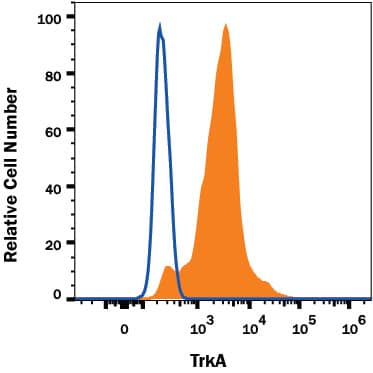Human TrkA Alexa Fluor® 488-conjugated Antibody
R&D Systems, part of Bio-Techne | Catalog # FAB1751RG


Key Product Details
Species Reactivity
Applications
Label
Antibody Source
Product Specifications
Immunogen
Ala33-Glu407
Accession # P04629
Specificity
Clonality
Host
Isotype
Scientific Data Images for Human TrkA Alexa Fluor® 488-conjugated Antibody
Detection of TrkA in HEK293 Cell Line Transfected with Human TrkA by Flow Cytometry.
HEK293 human embryonic kidney cell line transfected with human TrkA was stained with Mouse anti-Human TrkA Alexa Fluor® 488-conjugated Monoclonal Antibody (Catalog # FAB1751RG, filled histogram) or isotype control antibody (IC002G, open histogram). To facilitate intracellular staining, cells were fixed with Flow Cytometry Fixation Buffer (FC004) and permeabilized with Flow Cytometry Permeabilization/Wash Buffer I (FC005). Staining was performed using our Staining Intracellular Molecules protocol.Applications for Human TrkA Alexa Fluor® 488-conjugated Antibody
Intracellular Staining by Flow Cytometry
Sample: HEK293 Cell Line Transfected with Human TrkA
Formulation, Preparation, and Storage
Purification
Reconstitution
Formulation
Shipping
Stability & Storage
- 12 months from date of receipt, 2 to 8 °C as supplied.
Background: TrkA
TrkA, the product of the proto-oncogene trk, is a member of the neurotrophic tyrosine kinase receptor family that has three members. TrkA, TrkB, and TrkC preferentially bind NGF, NT-4 and BDNF, and NT-3, respectively. All Trk family proteins share a conserved complex subdomain organization consisting of a signal peptide, two cysteine-rich domains, a cluster of three leucine-rich motifs, and two immunoglobulin-like domains in the extracellular region, as well as an intracellular region that contains the tyrosine kinase domain. Two distinct TrkA isoforms that differ by virtue of a 6-amino acid insertion in their extracellular domain have been identified. The longer TrkA isoform is the only isoform expressed within neuronal tissues whereas the shorter TrkA is expressed mainly in non-neuronal tissues. NGF binds to TrkA with low affinity and activates its cytoplasmic kinase, initiating a signaling cascade that mediates neuronal survival and differentiation. Higher affinity binding of NGF requires the coexpression of TrkA with the p75 NGF receptor (NGF R), a member of the tumor necrosis factor receptor superfamily. NGF R binds all neurotrophins with low affinity and modulates Trk activity as well as alters the specificity of Trk receptors for their ligands. NGF R can also mediate cell death when expressed independent of Trk.
References
- Esposito, D. et al. (2001) J. Biol. Chem. 276:32687.
- Sofroniew, M.V. et al. (200) Annu. Rev. Neurosci. 24:1217.
Long Name
Alternate Names
Gene Symbol
UniProt
Additional TrkA Products
Product Documents for Human TrkA Alexa Fluor® 488-conjugated Antibody
Product Specific Notices for Human TrkA Alexa Fluor® 488-conjugated Antibody
This product is provided under an agreement between Life Technologies Corporation and R&D Systems, Inc, and the manufacture, use, sale or import of this product is subject to one or more US patents and corresponding non-US equivalents, owned by Life Technologies Corporation and its affiliates. The purchase of this product conveys to the buyer the non-transferable right to use the purchased amount of the product and components of the product only in research conducted by the buyer (whether the buyer is an academic or for-profit entity). The sale of this product is expressly conditioned on the buyer not using the product or its components (1) in manufacturing; (2) to provide a service, information, or data to an unaffiliated third party for payment; (3) for therapeutic, diagnostic or prophylactic purposes; (4) to resell, sell, or otherwise transfer this product or its components to any third party, or for any other commercial purpose. Life Technologies Corporation will not assert a claim against the buyer of the infringement of the above patents based on the manufacture, use or sale of a commercial product developed in research by the buyer in which this product or its components was employed, provided that neither this product nor any of its components was used in the manufacture of such product. For information on purchasing a license to this product for purposes other than research, contact Life Technologies Corporation, Cell Analysis Business Unit, Business Development, 29851 Willow Creek Road, Eugene, OR 97402, Tel: (541) 465-8300. Fax: (541) 335-0354.
For research use only